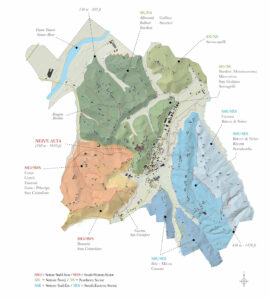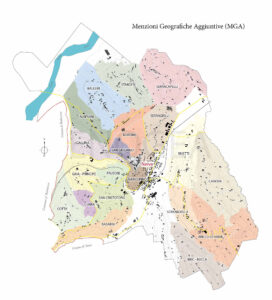Number of MGAs: 20
Number of Wineries: 47
The different topography of the territory of Neive, compared to Barbaresco, also results in a different descriptive approach. No longer a division into slopes, but rather a division into macro-areas or Sectors, clearly distinguishable in the map below, which will also assist you in orienting yourself among the different panoramic images, particularly the first, third and seventh.

1. Northern sector (NS). Of the three sectors, this is certainly the most uniform in terms of elevation as well as the easiest to schematize. With the exception of the Serracapelli hill (second image), somewhat isolated at the northeastern border of the zone – and where wines are noted more for harmony than vigor – the rest of the area is characterized by a series of gentle ridges forming a landscape not at all unusual for this part of the Langhe. In particular, starting from the west, four different ridges almost parallel to each other can be identified – Gallina, Albesani, Balluri and Starderi – among which the most renowned slope is that facing Barbaresco in directions varying between south and west (third image). Gallina stands out for the concrete elegance of its wines, Albesani for the touches of warm austerity they can attain, Starderi for the color and fullness of their tannic structure, whereas the wines of Balluri up to now are less distinguished. To these four ridges can be added a fifth, Bordini, adjacent to the others with an excellent southeastern exposure and noted for wines of solid style if a bit more tense than those of Gallina and Albesani(second image). The Bordini MGA crosses a small valley and continues up a hill known as Montesommo, which is part of the last group of hills of the sector. This area takes in, toward the south, the Marcorino MGA on a south-facing slope renowned for the subtle elegance of its Barbaresco, and San Giuliano, whose wines express a more tense and tannic character. Finally, to the east is the small Serragrilli MGA, which represents a sort of liaison, both in terms of the style of wines and landscape, with the Serracapelli MGA.
2. Southwestern sector (SWS). To keep things simple, this sector can be depicted as an enormous mound at the top of which is situated the Cascina San Cristoforo, one of the most useful visual references of the denomination (fourth and fifth image). The southern slope, steep and majestic, hosts the Basarin MGA (sixth image) while the eastern slope includes a large part of the San Cristoforo MGA (seventh image). The opposite slope, facing Barbaresco, is more articulated and marked by continuous alterations of exposures and soils as reflected in the styles of the wines (fifth and sixth imagine). The wines of Currà and Cottà tend to be full bodied, with more austerity in the latter, those of Gaia-Principe are noted as fruity, while the Barbaresco of Fausoni show earthy qualities. The Barbaresco of Basarin is always recognizable for elegance, while that of San Cristoforo has good substance but is less nuanced than those of Currà and Cottà.
3. Southeastern sector (SES). Of the three sectors, this is the most linear in form, consisting of four different ridges descending from north to south (eight and ninth image): Casasse to the right (which is not part of any MGA), Bric-Micca, Serraboella (which, in addition to the MGA of the name, also includes the MGAs of Rivetti and Bricco di Neive) and Canova. The vineyards of this sector are divided between the cultivation of two grape varieties. Moscato in the cooler areas, such as the eastern side of Canova and Bricco di Neive; Nebbiolo in the warmer areas facing west and southwest, among which Serraboella, Bricco di Neive and Bric-Micca stand out. As for the styles of wines, Barbaresco from these MGAs usually has solid and sometimes austere structure, with rough touches in the case of Serraboella. The wines of Canova are similar in style, at least from vineyards on its western side, while those of Rivetti, from soils easily recognizable for a reddish hue, are usually richer in color and require less aging in bottle.

